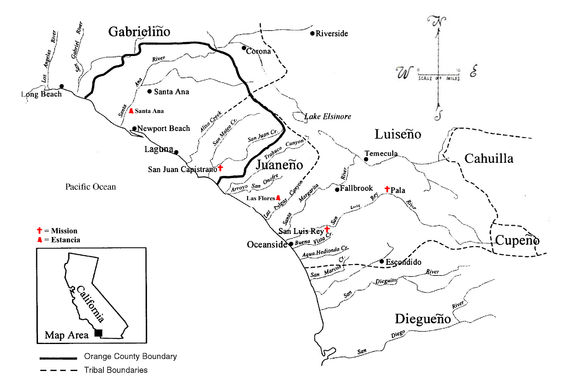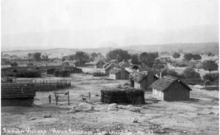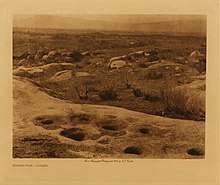Cupeño
The Cupeño are a Native American tribe of Southern California. Their name in their own language is Kuupangaxwichem ("people who slept here.")[2][3]
 The territorial boundaries of the Southern California Indian tribes based on dialect, including the Cupeño language | |
| Total population | |
|---|---|
| 1,000 (1990)[1] | |
| Regions with significant populations | |
| Languages | |
| English, Spanish, formerly Cupeño language | |
| Religion | |
| Traditional tribal religion, Christianity (Roman Catholic, Protestant) | |
| Related ethnic groups | |
| Cahuilla, Luiseño, Serrano, and Tongva |
They traditionally lived about 50 miles (80 km) inland and 50 miles (80 km) north of the modern day Mexico–United States border in the Peninsular Range of Southern California.[3] Today their descendants are members of the federally recognized tribes known as the Pala Band of Luiseno Mission Indians, Morongo Band of Cahuilla Mission Indians, and Los Coyotes Band of Cahuilla and Cupeno Indians.[4]
History


Map of Cupeño villages with Warner Springs for reference
Several different groups combined to form Cupeño culture around 1000 to 1200 AD. They were closely related to Cahuilla culture.[5] The Cupeño people traditionally lived in the mountains in the San Jose Valley at the headwaters of the San Luis Rey River.[6] They lived in two autonomous villages, Wilákalpa and Kúpa,[4] also spelled Cupa, located north of present-day Warner Springs, California. They also lived at Agua Caliente, located east of Lake Henshaw in an area crossed by State Highway 79 near Warner Springs. The 200-acre (0.81 km2) Cupeño Indian village site is now abandoned but evidence of its historical importance remains.[7]
Spaniards entered Cupeño lands in 1795[6] and took control of the lands by the 19th century. After Mexico achieved independence, its government granted Juan Jose Warner, a naturalized American-Mexican citizen, nearly 45,000 acres (180 km2) of the land on November 28, 1844. Warner, like most other large landholders in California at the time, depended primarily on Indian labor. The villagers of Kúpa provided most of Warner's workforce on his cattle ranch. The Cupeño continued to reside at what the Spanish called Agua Caliente after the American occupation of California in 1847 to 1848, during the Mexican–American War. They built an adobe ranch house in 1849 and barn in 1857, which are still standing.
According to Julio Ortega, one of the oldest members of the Cupeño tribe, Warner set aside about 16 miles (26 km) of land surrounding the hot springs as the private domain of the Indians. Warner encouraged the Cupeño to construct a stone fence around their village and to keep their livestock separated from that of the ranch. Ortega felt that if the village had created its own boundaries, the Cupeño would still live there today.[8] In observing the Cupeño's living conditions in 1846, W. H. Emory, brevet major with the United States Army Corps of Engineers, described the Indians as being held in a state of serfdom by Warner, and as being ill-treated.[9] In 1849, Warner was arrested by the American forces for consorting with the Mexican government and was taken to Los Angeles.
In 1851, because of several issues of conflict, Antonio Garra, a Yuma Indian, living at Warner's Ranch, tried to organize a coalition of various Southern California Indian tribes to drive out all of the European Americans.[10] His Garra Revolt failed, and settlers executed Garra. The Cupeño had attacked Warner and his ranch, burning some buildings. They lost structures at their settlement of Kúpa, too. Warner sent his family to Los Angeles, but continued to operate the ranch through others.
After European contact and prior to the time of their eviction, the Cupeños sold milk, fodder, and some craftwork to travelers on the Southern Immigrant Trail, as well as to passengers on the stagecoaches of the Butterfield Overland Mail, which stopped at Warner's Ranch and passed through their valley. The women made lace and took in laundry, which they washed in the hot springs. The men carved wood and manufactured saddle pads for horses. They also raised cattle and cultivated 200 acres (0.81 km2) of land. In 1880, after numerous suits and countersuits, European-American John G. Downey acquired all titles to the main portion of Warner's Ranch.
In 1892, John G. Downey, former governor of California and owner since 1880, began proceedings to evict the Cupeño from the ranch property. Legal proceedings continued until 1903, when the court ruled in Barker v. Harvey against the Cupeño. The United States Government offered to buy new land for the Cupeño, but they refused. In 1903, Cecilio Blacktooth, Cupeño chief at Agua Caliente, said: "If you give us the best place in the world, it is not as good as this. This is our home. We cannot live anywhere else; we were born here, and our fathers are buried here."[11]

On May 13, 1903, the Cupa Indians were forced to move to Pala, California on the San Luis Rey River, 75 miles (121 km) away. Indians at the present-day reservations of Los Coyotes, San Ygnacio, Santa Ysabel, and Mesa Grande are among descendants of the Warner Springs Cupeño. Many Cupeño believe that their land at Kúpa will be returned to them. They are seeking legal relief to that end. The Cupa site serves as a rallying point for the land claims movement of contemporary Indian people, particularly their effort to regain cultural and religious areas.
Culture
.jpg)
The tribe is divided into two moieties, the Coyote and Wildcat, which are divided into several patrilineal clans. Clans are led by hereditary male clan leaders and assistant leaders. Marriages were traditionally arranged.[4]

Traditional foods included acorns, cactus fruit, seeds, berries, deer, quail, rabbits, and other small game.[4][5]
The Cupa Cultural Center was founded in 1974 in Pala and underwent a major expansion in 2005. The center exhibits artwork, hosts classes and activities such as basket making and beading, and offers Cupeño language classes. During the first weekend of every May, Cupa Days is celebrated at the cultural center.[12]
Language
The Cupeño language belongs to the Cupan group, which includes the Cahuilla and Luiseño languages. This grouping is of the Takic branch within the Uto-Aztecan family of languages.[3] Roscinda Nolasquez (1892–1987), of Mexican Yaqui descent, is considered the last truly fluent Cupeño speaker.[13]
The language is widely regarded as being extinct. In 1994, linguist Leanne Hinton estimated one to five people still spoke Cupeño, and nine people in the 1990 US census said they spoke the language.[14] Educational materials for the language exist and young people still learn to sing in Cupeño, particularly Bird Songs.[15]
Population
Alfred L. Kroeber estimated the 1770 population of the Cupeño as 500. Lowell John Bean and Charles R. Smith put the total in 1795 between 500 and 750. By 1910, the Cupeño population had dropped to 150, according to Kroeber. Later estimates have suggested that there were fewer than 150 Cupeño in 1973,[10] but 200 in 2000.
Notes
- "California Indians and Their Reservations: P. SDSU Library and Information Access. (retrieved 18 May 2010)
- "Pala Band of Mission Indians - The History". Archived from the original on 2018-03-31. Retrieved 2018-03-30.
- "California Indians and Their Reservations. Archived February 5, 2009, at the Wayback Machine SDSU Library and Information Access. (retrieved 18 May 2010)
- Pritzker, 125
- Bean and Smith, 588
- Pritzker, 124
- "Cupa: San Diego County", A History of American Indians in California: HISTORIC SITES, National Park Service, accessed 18 Nov 2009
- Morrison, 1962, p.21
- May 1902, Out West, p. 471
- Bean and Smith, 589
- May 1902, Out West, p.475
- "Cupa Cultural Center", Pala Band of Mission Indians. 2006 (retrieved 18 May 2010)
- Brigandi, P. "Roscinda Nolasquez Remembered." The Journal of California and Great Basin Anthropology. 9 (1) 2009: 3.
- Hinton, 28
- Hinton, 29, 42
References
- Bean, Lowell John, and Charles R. Smith. "Cupeño". Heizer, Robert F., volume ed. Handbook of North American Indians: California, Volume 8. pp. 91–98. Washington, DC: Smithsonian Institution, 1978. ISBN 978-0-16-004574-5.
- Hinton, Leanne. Flutes of Fire: Essays on California Indian Languages. Berkeley: Heyday Books, 1994. ISBN 0-930588-62-2
- Pritzker, Barry M. A Native American Encyclopedia: History, Culture, and Peoples. Oxford: Oxford University Press, 2000. ISBN 978-0-19-513877-1.